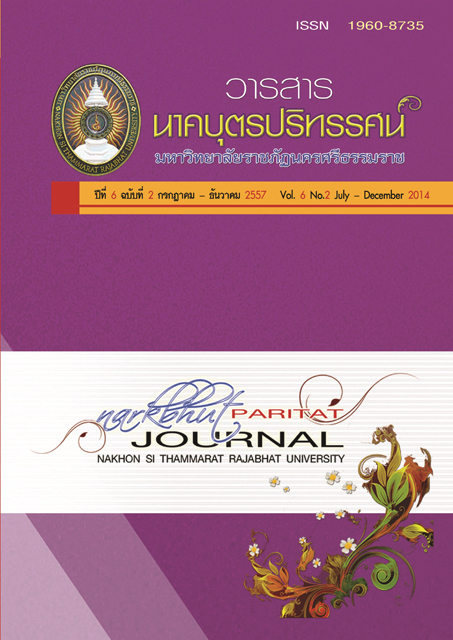การประเมินโครงการครอบครัวร่วมทำน้อมนำปรัชญาของเศรษฐกิจพอเพียงโรงเรียนบ้านสระบัว
Main Article Content
Abstract
การประเมินโครงการครั้งนี้มีวัตถุประสงค์เพื่อประเมินผลการดำเนินโครงการครอบครัวร่วมทำน้อมนำปรัชญาของเศรษฐกิจพอเพียง โรงเรียนบ้านสระบัว โดยใช้แนวคิดการประเมินของ Danial L. Stufflebeam รูปแบบการประเมินแบบ CIPPIEST Model ประกอบด้วย 1) การประเมินด้านบริบท (C : Context Evaluation) 2) ด้านปัจจัยนำเข้า (I:Input Evaluation) 3) การประเมินกระบวนการ (P:Process Evaluation) 4) ด้านผลผลิต (P: Product Evaluation) 5) การประเมินด้านผลกระทบ (I:mpact Evaluation) 6) การประเมินด้านประสิทธิผล (E : Effectiveness Evaluation) 7) การประเมินด้านความยั่งยืน (S:Sustain-ability Evaluation) และ 8) การประเมินด้านการถ่ายโยงความรู้ (T:Tran-sportability Evaluation) เก็บ รวบรวมข้อมูลโดยใช้แบบประเมิน และแบบทดสอบ จากผู้มีส่วนเกี่ยวข้อง ได้แก่ ครูผู้สอน คณะกรรมการสถาน ศึกษาขั้นพื้นฐาน ผู้ปกครอง และนักเรียน
ผลการประเมินพบว่าผลการประเมินโดยรวมอยู่ในระดับมาก แยกเป็นรายด้าน ดังนี้ด้านสภาพแวดล้อมโดยรวม ผลการประเมินมีความเหมาะสมอยู่ในระดับมาก ( = 4.21, S.D.=0.57) ด้านปัจจัยนำเข้า มีผลการประเมิน อยู่ในระดับมาก (
= 4.16, S.D.=0.57) ด้านกระบวนการมีผลการประเมินอยู่ในระดับมาก (
= 4.15, S.D.=0.72) ด้านผลผลิต ผลการทดสอบส่วนใหญ่อยู่ในระดับดี (13 - 16คะแนน) ร้อยละ 46.28 มีความเข้าใจเกี่ยวกับเศรษฐกิจพอเพียงอยู่ในระดับมาก (
= 4.09, S.D.=0.83) และมีความพึงพอใจต่อโครงการอยู่ระดับมาก (
= 4.17,S.D.=0.82) ด้านผลกระทบมีผลกระทบในด้านบวกต่อนักเรียน ครูผู้สอน และผู้ปกครองและชุมชนอยู่ในระดับมาก (
= 4.05, S.D.=0.74) ด้านประสิทธิผลโครงการ มีประสิทธิผล อยู่ในระดับมาก (
= 4.05, S.D.=0.87) ด้านความยั่งยืนโครงการ มีผลการประเมินอยู่ในระดับมาก (
= 3.98, S.D.=0.74) และด้านการถ่ายโยงความรู้โครงการมีผลการประเมินอยู่ในระดับมาก (
= 4.03, S.D.=0.78)
The evaluation of the participatory program for BanSraBua students’families to put the sufficiency economy philosophy into practice
The objective of the evaluation research is to evaluate the implementation of the participatory program for BanSraBua students’ families in order to put the sufficiency economy philosophy into practice. The Stufflebeam’s evaluation approach; the CIPPIEST Model, is mainly employed. This approach consists of 8 dimensions which are as follows: 1) Context evaluation (C); 2) Input evaluation (I); 3) Process evaluation (P); 4) Product evaluation (P); 5) Impact evaluation (I); 6) Effectiveness evaluation (E); 7) Sustainability evaluation (S) ; and 8) Transportability evaluation (T).Research instruments are an evaluation form and attest collected data from teachers, board of the basic education committee, students’ parents and students.
Research findings are as follows: In general, the overall score of the program was at a very good level. In regard to each dimension, the context evaluation score was at a very good level ( = 4.21, SD = 0.57). The input evaluation score was also at a very good level (
= 4.16, SD = 0.57) and, again, the process score was at a very good level (
= 4.15, SD = 0.72). The product evaluation score was at a good level (13 to 16 marks, equivalent to 46.28%), the understanding score was at a very good level (
= 4.09, SD = 0.83) and the satisfaction towards the program was at a very good level (
= 4.17, SD = 0.82). The evaluation of the program’s impacts on students, teachers, parents and communities was at a very good level (
= 4.05, SD = 0.74). Likewise, the effectiveness of the program was at a very good level (
= 4.05, SD = 0.87). Finally, the sustainability score was at a very good level (
= 3.98, SD = 0.74) and the transportability evaluation score was at a very good level (
= 4.03, SD = 0.78).


